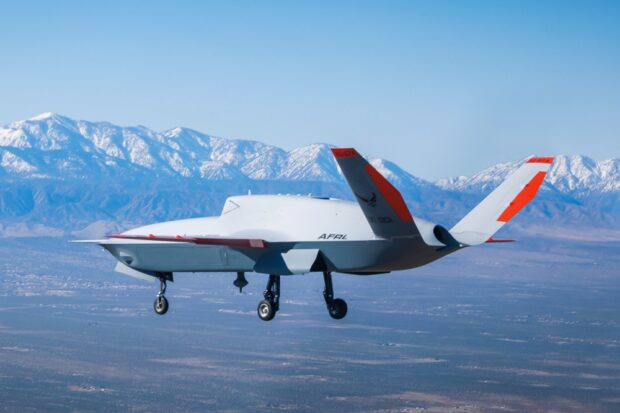General Atomics’s first prototype for the US Air Force’s autonomous combat drone program could start flight tests as early as mid-2025, the head of its aeronautics division told Breaking Defense in a recent interview.
Legacy drone maker General Atomics and defense tech startup Anduril in April defeated mega primes Lockheed Martin, Northorp Grumman and Boeing for contracts to make the first batch of prototypes for the Collaborative Combat Aircraft program.
The Air Force has yet to declare whether it will carry both companies — or just one — into production for the first increment of the program, which will see the firms square off to build uncrewed aircraft that can battle fighter jets at a cost of a fraction of a crewed fighter. But General Atomics is determined to make the service’s decision easy by moving quickly and proving its design is mature enough to be built en masse, said David Alexander, president of General Atomics Aeronautical Systems.
“We’re not just designing another stunt. We’re designing something you can go into full rate production on,” he said on the sidelines at the Royal International Air Tattoo last weekend. “We are heads down to beat the competition, no matter who it is. Whether it’s Anduril, who’s still in it, or the other three [competitors] that are trying to claw their way back in.”
The company has started building components for its first CCA prototype, which is set to roll off the production line next year, he said.
If General Atomics is selected to move forward with full rate production, it already has the facilities and capital infrastructure needed to ramp up production on the CCA program due to the upcoming sunset of the Army’s MQ-1C Gray Eagle and Air Force’s MQ-9A Reaper production lines, which will be down to two aircraft a month next year. General Atomics’ drone production peaked at about 8.5 aircraft per month in 2019, and Alexander said its current infrastructure would support a rate even higher than that for CCA production.
“We have this huge production gap. We have to be aggressive here — we have jobs on the line to fill that production line back up,” he said. “But we can easily do this program and build what they need easily, and it wasn’t that long ago when we were doing it.”
Under the current contract, General Atomics is on order for a “small number” of CCAs for development and testing, Alexander said.
However, Air Force leaders have said it could buy more than 1,000 drones over the course of the program, making it an unquestionably lucrative opportunity — particularly as the service considers whether to delay or cancel its next-generation fighter jet program.
General Atomics has said it derived its CCA design from its Gambit family of drones as well as the XQ-67A Off Board Sensing Station (OBSS) demonstrator it built for Air Force Research Laboratory that first flew in February. But Alexander noted that the CCA design is markedly different due to the air-to-air combat mission, which calls for faster speeds and a different flight envelope than the surveillance mission for which the OBSS platform was designed.
Alexander declined to comment on which engines the company is considering for its CCA variant as well as the other defense companies who are building the sensors and other mission systems that will be integrated into the aircraft.
Round Two… Fight!
Production of the first increment of CCA prototypes has just started, but companies have already started eyeing the second increment of the program. The Air Force has said little about how the second CCA round will differentiate itself from the requirements of the first batch, but stated in April that planning was ongoing and that “initial activities” are set to start later this year.
Alexander declined to comment on what new capabilities General Atomics could offer for the second increment.
“We’re going to be in it, and we’re going to be in it big,” Alexander said.
Boeing and Lockheed Martin are both also interested in returning to the CCA competition for increment two despite a loss on the first round of the program, top executives said during the Farnborough Airshow this week.
“We’re interested,” said Greg Ulmer, president of Lockheed Martin’s aeronautics unit. “We’re doing a lot of design development experimentation with CCA. We’re doing a lot of study of how you control and manage CCAs.”
Boeing’s current experiences building and developing the Navy’s MQ-25 tanker drone and Australia’s MQ-28 Ghost Bat are also helping the company push forward innovations in advanced materials, autonomy, software and artificial intelligence that can be parlayed into future CCA increments, said Boeing Space and Security CEO Ted Colbert.
“Unless there are contract terms that we just can’t sign up to or it’s a request that’s completely askew to our portfolio, we’re going to compete in every increment that comes forward in the space,” he said. “We’re going to invest, we’re going to keep competing and the sweet spot of intersection of the requirements for the customer and our capability will happen.”
Photo: The Air Force Research Laboratory’s XQ-67A Off Board Sensing Station designed and built by General Atomics, in its first flight on Feb. 28 from Gray Butte Field Airport, Palmdale, California. General Atomics is pitching its Gambit drone design, which the XQ-67A is based on, for the Air Force’s CCA program. (Air Force photo)
Source: Breaking Defense

